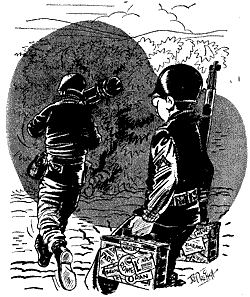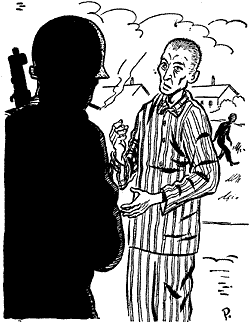|
|
|
|
XIV The Last Ten Days of the War |
|
We were going back into combat! The thought of it brought a momentary icy sensation to
the heart, but we who had stormed ashore at Salerno, driven the Germans north from Rome,
assaulted the beaches of France and defied history by forging the Vosges Mountains had
felt that it would be an unkind and obscure destiny to be left on the west  bank of the Rhine as the American Volkssturm*
Divisions drove into the heart of the Third Reich. It is strange how soon men forget the
terrifying screech of an incoming shell and the merciless chatter of a German machine gun. bank of the Rhine as the American Volkssturm*
Divisions drove into the heart of the Third Reich. It is strange how soon men forget the
terrifying screech of an incoming shell and the merciless chatter of a German machine gun.On the 26th of April we entrucked and crossed the Rhine River on the Ludwigshafen-Mannheim pontoon bridge and rolled through the green, rolling farmlands of Southern Germany. After leaving the bomb shattered cities on the Rhine, there was little of the destruction that is the aftermath of war. We were impressed with the healthy, well-fed appearance of the Germans and the outward neatness of the rural villages. Only in Crailsheim did we see the telltale indication that war had lingered here for a moment — long enough to leave it as hollow and gutted as the scorched-earth towns of France. By darkness we could hear artillery rumbling on the far side of the Danube; and GI's wearing the Blood and Fire patch** told us that some of their companies had successfully crossed the Danube that morning — good news to us. Here we were joined by our own Tanks and TD's — Company A of the 753rd Tank Battalion and Company B of the 636th TD Battalion — a dirty, weary and bewhiskered lot who had missed our rest west of the Rhine. We were glad to see them. Months of combat with these units had dispelled distrust that occasionally springs between Infantrymen and Tankers. Unfortunately it takes most of a war for a bunch of doughs and tankers to get together and function as a team; but by the time we started our drive into the much publicized Bavarian "Redoubt" these two units had become firmly welded to our regiment. The rest of the T Patch Division was trailing behind us at this time, and we were attached to the 63rd Division which was rolling to the southeast almost unopposed after crossing the Danube. The "rat race" was temporarily halted when we reached Schwabmunchen, south of Munich, and found all bridges of the Lech River blown and the tanks of the 12th Armored Division piled up for miles waiting to cross by the first bridge put in by the engineers.
Late on the 29th, the rain turned to a freezing sleet and finally to snow. Early on the last day of April we crossed the Lech with the 1st Battalion on armored vehicles leading, and the 2nd Battalion following on trucks — many of them huge and unwieldy amphibious six-by-sixes, or "Ducks". Our route lay along the west side of the Ammer See. As we approached the southern tip we caught our first glimpse of the snow covered Alps through the breaking clouds. It was a bitterly cold morning and all of our winter clothing had been turned in west of the Rhine. "It sure was a short summer," remarked a Charlie Company light machine gunner, clinging to the icy deck of a TD. Now, the 2nd Battalion was reenforced with armor and continued due south towards Penzberg while the 1st Battalion swung southeast towards Bad Tolz, the regimental objective. In this area we saw our last political prisoners wandering aimlessly along the roads, waving feebly as we rumbled past them. The mountainous Bavarian region we were entering had been utilized for summer homes of Nazi party leaders and SS hospitals and rest centers — the region that armchair strategists and tacticians had dubbed the "redoubt" for Nazism's last stand. Both Battalions ran into heavy resistance late in the afternoon and became engaged. The 2nd Battalion took Penzberg just before dark and immediately regained contact with the enemy at a blown bridge just east of the town. The 1st Battalion ran into a strongly defended roadblock just out of Seeshaupt and spent the remaining hours of daylight destroying a stubborn enemy in an intense small arms battle. All day during the 1st of May both battalions fought forward against small delaying forces toward Bad Tölz — the 1st from the north and 2nd from the west. Late in the afternoon the men from E Company made contact with the men from A Company, and the 1st Battalion with a preponderance of armor, more than twenty armored vehicles, rolled toward Bad Tölz as the rest of the 2nd Battalion was involved in an effort to extricate Company G from a bitter fight with SS Troops between Bad Heilbronn and Bad Tölz. Just before midnight the 1st Battalion reached the outskirts of the hospital and resort center of Bad Tölz. Just outside of this town an A Company Lieutenant and a ten man patrol captured Field Marshall Gerd von Rundstedt with his aide and son, a Lieutenant. As our leading tank approached the bridge across the Isar River in the center of the town, one demolition charge in the bridge was set off, but the Sherman rolled out onto the bridge, raking the far side of the river with its machine guns and 76 mm. fire. Charlie Company crossed the partially damaged bridge against heavy small arms fire and by daylight we had firmly secured the entire town. * GI slang reference to late arrival divisions in the ETO. ** The 63rd Infantry Division.
|
|
Copyright © 1945, 1998 141st Infantry Regiment
Association. |

 The 29th of April was a cold, wet and
morbid day. This part of Germany was dotted with concentration camps, and roadsigns
contained the names Dachau and Hurlach. The roadsides were littered with bodies, dead and
living, of the miserable inmates that had flooded out of the concentration camps as their
SS guards fled before American armored columns. Many of us saw Hurlach, but our minds
could not comprehend the sights, sounds and stenches we found there. Even minds
conditioned and fatigued by months of combat could not evaluate or accept this gruesome
sight. We regarded the emaciated political prisoners, wearing the familiar zebra striped
suits and peculiar knit caps, with mottled emotions of pity, anger, repulsiveness and awe.
The 29th of April was a cold, wet and
morbid day. This part of Germany was dotted with concentration camps, and roadsigns
contained the names Dachau and Hurlach. The roadsides were littered with bodies, dead and
living, of the miserable inmates that had flooded out of the concentration camps as their
SS guards fled before American armored columns. Many of us saw Hurlach, but our minds
could not comprehend the sights, sounds and stenches we found there. Even minds
conditioned and fatigued by months of combat could not evaluate or accept this gruesome
sight. We regarded the emaciated political prisoners, wearing the familiar zebra striped
suits and peculiar knit caps, with mottled emotions of pity, anger, repulsiveness and awe.